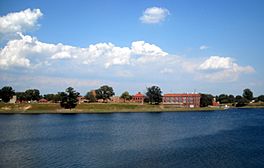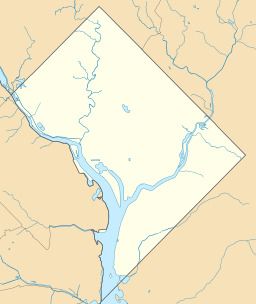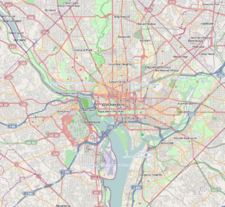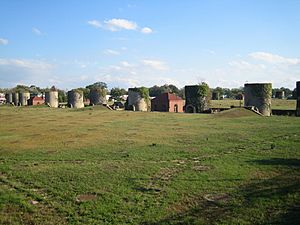McMillan Reservoir facts for kids
Quick facts for kids McMillan Reservoir |
|
|---|---|
 |
|
| Location | Washington, D.C. |
| Coordinates | 38°55′30″N 77°01′02″W / 38.9251°N 77.0173°W |
| Type | reservoir |
| Primary inflows | Washington Aqueduct |
| Basin countries | United States |
| Surface area | 25 acres (10 ha) |
The McMillan Reservoir is a large reservoir in Washington, D.C.. It provides most of the drinking water for the city. It was first called the Howard University Reservoir or the Washington City Reservoir. The U.S. Army Corps of Engineers finished building it in 1902.
Contents
How the Reservoir Was Built
The McMillan Reservoir was built in 1902. It was placed where a natural spring called Smith Spring used to be. Early residents of Washington, D.C., got their water from springs. But as the city grew, these springs were not enough. In 1850, the United States Congress decided that the Potomac River should be the main water source.
The Washington Aqueduct
Lieutenant Montgomery C. Meigs led the work to build the Washington Aqueduct. This system started working on January 3, 1859. At first, it brought water from the Little Falls Branch in Maryland. The full aqueduct, bringing water from the Potomac River, began service in 1864.
The Washington City Tunnel
In the beginning, water flowed through two older reservoirs: Dalecarlia and Georgetown. These reservoirs helped dirt and sediment settle out of the water. In 1882, the Army started building a new water supply tunnel. Major Garrett Lydecker of the Army Corps of Engineers led this project.
The new Washington City Tunnel was meant to store more water. It also helped clean the water better and distribute it to the city. Building the tunnel was difficult. Workers faced problems with different types of soil and rock. There were also issues with surveying and lining up the tunnel sections.
Construction of the tunnel stopped in 1888 for a while. Work on the tunnel started again in 1898. The tunnel was finished in 1901. The McMillan Reservoir then began operating in 1902.
Cleaning the Water: Filtration Plant
By 1902, people realized that just letting dirt settle was not enough. It did not remove tiny germs like bacteria that could make people sick. To help with the growing city and its health needs, a new facility was built in 1905. This was the McMillan Sand Filtration Site.
This facility used a new way to clean water called slow sand filter technology. It could treat 75 million gallons (280 million liters) of water every day. This new system helped stop diseases like typhoid from spreading in the city.
In 1907, the reservoir and the filtration plant were named after Senator James McMillan. He was from Michigan and supported building these water facilities. In March 1911, Congress officially made the site a park.
More improvements were made to the city's water system starting in the 1920s. In 1923, chlorine began to be used as a disinfectant at the McMillan plant. Another water treatment plant was finished in 1928. It was next to the Dalecarlia Reservoir and used a newer method called a rapid sand filter.
In 1941, during World War II, the entire site was closed off and fenced. This was done for security reasons, to protect it from possible attacks.
After the war, the property stayed closed to the public. However, it continued to provide filtered water to the city. As the city grew, the Dalecarlia site was expanded in the 1950s. In 1985, the slow sand filtration system at McMillan was replaced. A new rapid sand filtration system was built next to the old one.
In 1986, the Army Corps of Engineers stopped using the old slow sand filtration site. The District of Columbia government bought the old treatment site in 1987. Over time, the site started to fall apart because it was not maintained.
In 1991, the McMillan Reservoir site was named a D.C. Historic Landmark. In 2000 and again in 2005, it was put on a list of "Most Endangered Properties."
The leftover materials from the water treatment process are handled at a special facility. This facility is located at the Dalecarlia Reservoir and started working in 2012.
McMillan Fountain
The McMillan Fountain is a public artwork found on the Reservoir grounds. It was created by American artist Herbert Adams. The fountain was finished in 1912 and officially opened in October 1919.
It features a bronze sculpture of The Three Graces on a pink granite base. The fountain was a tribute to James McMillan. People from Michigan helped pay for it. They raised $25,000 with small donations from public school children. Congress also gave $15,000 to help finish the fountain.
Future Plans for the Filtration Site
See also




